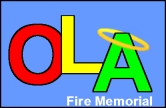
| Our Lady of the Angels (OLA) School Fire, December 1, 1958 |
NFPA Journal
September/October 1997
Burning Issues
Learning from the Schools
When it comes to fire safety, our schools seem to be among the safest buildings. Why? And what can we learn from them that will help us make other occupancies just as safe?
Jenna Von Dietsch
It's September - do you know where your kids are? They should be in school, and that's good news when it comes to fire prevention and protection. Schools are among the safest buildings in this country. This wasn't always the case, however.
Historical school fires
The all-time deadliest school fire in the United States occurred 60 years ago in 1937 in New London, Texas, when a natural gas explosion killed 294 students and teachers at the New London Junior-Senior High School. Leaking gas ignited when a teacher pulled an electric plug out of a wall socket, blowing the roof off the building and causing the floors to collapse.
Twenty-one years later, in 1958, 92 children and 3 adults died in a fire at the Our Lady of the Angels School in Chicago, Illinois. The school was of ordinary construction and had no fire detection or fire suppression systems, although it was equipped with a local alarm system.
According to officials, an arsonist started the fire in a pile of garbage under a stairway in the school's basement. Open stairways allowed the fire to spread to the second floor and fill the halls with toxic smoke.
The current situation
Four thousand fires per year, or 51.1 percent, of all the educational facility fires that occurred between 1990 and 1994 - the last year for which we have reliable figures - were of incendiary or suspicious origin. Those deliberatley set fires also caused all the deaths, half the injuries, and three-fifths of the property damage. Another 700 fires per year, or 9.0 percent, were associated with electrical distribution systems.
Deaths in the United States in educational facility fires between 1990 and 1994 averaged less than one a year. However, a total of 174 people were injured. The majority of injuries resulted from fires of incendiary or suspicious origin. What makes schools so safe today?
NFPA 101®, Life Safety Code®, dictates that educational facilities have a properly sized and maintained egress system. The Code requirements address corridor walls, panic hardware for releasing door latches, rescue and ventilation windows, emergency lighting, protection of floor openings, and other related features.
In addition to the building egress features, the Code requires that schools be equipped with a fire alarm system that's installed, tested, and maintained in accordance with applicable requirements of NFPA 72, National Fire Alarm Code, and NFPA 70, National Electrical Code®.
It's required that school occupants be notified of a fire by alarm signals, which should operate throughout the building. The alarm needs to be loud enough to be heard above the average ambient sound level in the school. And the sound of the fire alarm must be distinguishable from audible signals used for other purposes in the building, such as the bell to signal the end of a class period. The Life Safety Code® also mandates that educational occupancies conduct at least one fire exit drill during each month the facility's in operation. During the first 30 days of operation, an additional fire drill is required. Drills are required to be held at different hours of the day - while students are changing classes, when the school is at assembly, during recess or gym periods, or at other times - so that students won't come to expect a fire drill at any certain time.
During drills and actual emergencies, each class or group must proceed to a predetermined point outside the building and remain there while a check is made to be sure everyone's accounted for.
Fire drills shouldn't include any fire extinguishing operations. Such training and practice is better left to instructors and other employees.
Table 1--Number of Fires in Selected Educational Facilities, 1990 to 1994, Annual Averages
| Type of Schools | Number of Fires | Number of Injuries |
| Nursery schools | 129 | 1 |
| Kindergartens | 35 | 0 |
| Elementary schools | 1,666 | 36 |
| Junior high schools | 1,185 | 21 |
| High schools | 2,330 | 57 |
| Residential schools | 405 | 12 |
| Vocational, trade schools | 149 | 5 |
| Business schools | 21 | 0 |
| Specialty schools | 86 | 1 |
| College classroom buildings | 551 | 14 |
| Back | Top of Page | Home |